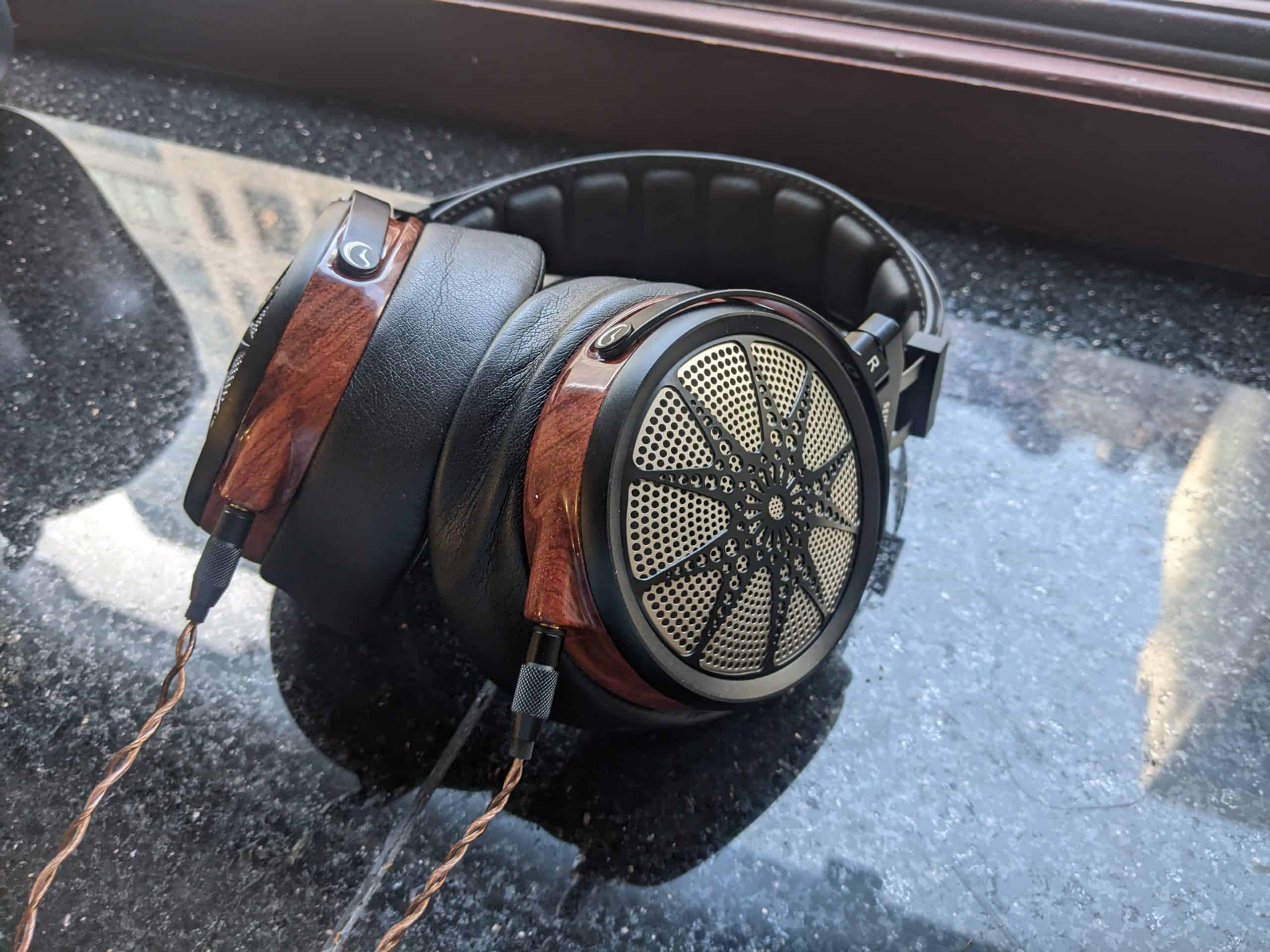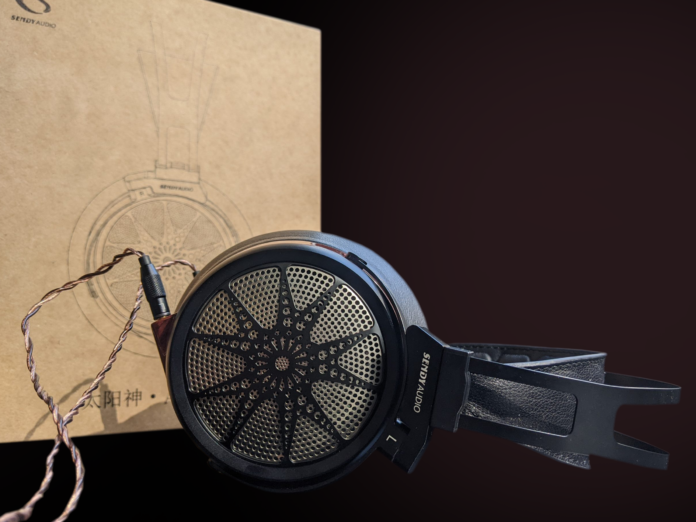Sendy Audio Apollo Review
Sendy Audio is an offshoot of Sivga’s parent company that specializes in making wooden headphones – and earphones, for that matter. While Sivga has several sub $250 offerings with a handful of somewhat higher-end models, Sendy has a smaller collection of seemingly more premium models – the most affordable of which is the Apollo, an open-back planar headphone that goes for $499. Let’s take a look inside the box, go over some of its technical design, and finally, see if the Sendy Apollo can prove itself a worthy mid-fi offering.
What’s In the Box?

- Sendy Audio Apollo Open-Back Headphones
- Detachable Cable with 4.4mm Balanced Jack
- 4.4mm to 3.5mm Adapter
- Hard Case
- Cable Pouch
Look and Feel
The most apparent physical quality of Sendy’s Apollo is its rich rosewood housing, followed by the steel mesh on the can’s open-back grill that follows what Sendy calls a “sunlight design.” The headphones frame is composed of what appears to be steel, and seems fairly durable and moderately flexible. The headband support mechanism comes from a manually adjustable synthetic leather suspension headband. At 395 grams, the Apollo weighed on my head fairly comfortable, and didn’t leave a strong impression on me as being heavy nor light.
I most have good things to say for the fit: my ears didn’t touch the driver, weight was comfortably distributed, headband pressure was relaxed but still secure. I’m usually not such a fan of manual adjustment suspension bands, but subjective preferences aside, this one didn’t give me much of an issue. My only issue with the fit is with the ear pads, which are memory foam encased with synthetic leather. The consistency of the memory foam is comfortable and squishy, but the cheap synthetic leather could get a bit hot on my ears. In the scope of cost-of-production priorities, I could live with the synthetic leather; it’s not terribly uncomfortable, but it’s not exactly ideal. Ultimately, I didn’t have an issue wearing the Sendy Apollo on my head for hours at a time.
Technical Design and Specs
The Sendy Apollo makes use of a 68mm planar driver made of “double magnets + double sides of coils on the diaphragm + double coils on each side of the diaphragm.” This design, according to Sendy, results in low distortion and greater consistency in the diaphragm’s vibrations. A “damping bass material in the composite diaphragm” leads to “soft vocals as well as solid bass,” and its thinness and rigidity contributes to a detailed treble extension.
| Spec | Sendy Audio Apollo |
| Operating Principle/Driver | Open-Back / 68mm Planar Driver |
| Impedance | 16 ohms |
| Frequency Response | 20 Hz – 40 kHz |
| Sensitivity | 95 dB |
Soundstage
Staging and imaging was likely what impressed me the most with Sendy’s Apollo. The intro of “I’m On Fire” by The Chromatics presented itself with a realistic depth, giving me a sense that the fade-in of palm-muted guitars started far from my face and increased in proximity as the track reached its full volume. Width is felt the most at greater depths, or figuratively speaking, “distances.” To put it simply, it’s not unlike sitting front and center at a concert and experiencing the resulting interplay of width and depth that comes from a live stage; another characteristic to demonstrate this is the way hard pans could still maintain a sense of distance from my ears, while prominent mono parts such as lead vocals felt closer to my face. Overall, the Apollo’s stage is pretty fluid and engaging with no shortage of spatial qualities.

Lows
I feel teased by the Apollo’s lows. There’s enough meat in the mid bass to give kick drums a tight thump that is lightly felt and even borders on slam, but a significant sub-bass roll off holds back on producing a truly exciting impact that the Apollo seems just a hair away from delivering.
Being light on the subs, the Sendy Apollo finds a low-frequency profile that concerns itself more with its mid and high bass. Though I’m often critical of balances that put much stock in their high bass, I think the Apollo pulls it off pretty tastefully and in such a way that avoids a muddy signature. Accompanied with a solid speed in the low-end, the mid and high bass emphasis imparts a firmness not only onto kick drums, but to the thumpy transients on snare drums and the warmth in analog synths. So, while I think a little more sub energy from the Apollo would make this an excellent low end, the low end as it stands is nonetheless tight, pleasant, and warm.
Mids
Here in the mid range is where the Apollo makes some controversial statements. It’s not everyday I come across a headphone where its center mid emphasis jumps out at me, but that’s exactly what we have with the Sendy Apollo. Center mid boosts are notorious for producing boxy sound signatures – and the Apollo, at its worst, can be a little boxy, which is an obfuscating trait when it comes to dense reverbs on vocals, guitars, and synths. However, this elevated center mid range, accompanied by the firm warmth in the low end, created a dry, warm impact on acoustic drums. In fact, I would say drums are the Apollo’s strong suit, as their tight and dark density pop through mixes. Vocals, as Sendy promises in their literature, do in fact have a softer quality that thankfully avoids overemphasized fundamentals, and ultimately retain enough of their overtones for a clear presentation. The mids profile seems to find its prominence, in part, due to what we hear in the Apollo’s treble tuning.
Highs
Some headphones see a ramp in their low treble, a range where human ears are physiologically programmed to feel “pain,” but the Apollo is taking absolutely no chances; it’s a smooth signature, and Sendy wants to keep it that way. Low treble is scooped with a heavy hand, likely by creative design. This takes some harmonic sweetness out of guitars, and results in coloring vocals by stripping them of their upper overtones. I also found this scoop was partly responsible for the forwardness of the Sendy Apollo’s mids – they stood out as being vastly distinct from the treble, and vice verse. As I basically just implied, there’s pretty solid separation occurring in the highs, with a more natural and reasonable amplitude returning to the mid and even high treble. The remaining, upper end of the Sendy Apollo’s high frequencies save its signature from coming off as pillowy or muted – reverbs find their form in this range, casting a specter of brightness that emanates and floats around the otherwise warm and dense balance.
Overall
The Apollo at first left me a little confused, but grew on me when I started to accept that it’s not right for every genre. I had the best luck with music that can be generally described as having a beat – no, not just a drum part, distinctly a beat. The low end speed and warmth coupled with emphasized center mids gave drums a tight and dry quality, and while this balance didn’t leave vocals sounding natural, they were nonetheless darkly pleasant. Maybe its the rosewood in the build influencing my choice of words here, but there is a rustic, pretty, and cozy quality to the Sendy’s balance that’s well complimented by an engaging and fluid stage. The Sendy Apollo may not be right for some one who is looking to own just one pair of headphones, but it can fill a distinct niche for some one considering a new mid-range addition to their collection.
The Sendy Audio Apollo is available here from Audio46.
Compare the ranking of various headphones, earbuds and in-ear monitors using our tools.
Discuss this, and much more, over on our forum.
---MAJORHIFI may receive commissions from retail offers.














